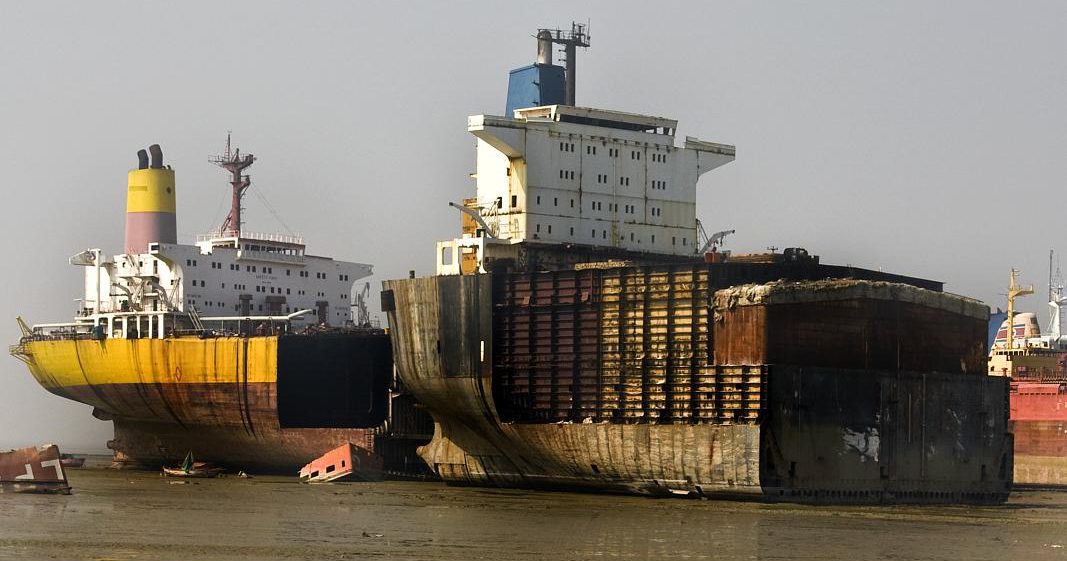Shipbreaking near Chittagong, Bangladesh, image by Naquib Hossain
(Dow Jones) Shipping companies are demolishing their vessels at an unprecedented rate this year, hoping to eliminate some capacity to cushion the impact of a flood of newly built ships entering the market.
The record-setting ship scrapping comes as charter rates have dropped to new historical lows, which in some cases are barely enough for companies to recover a vessel’s operating and financing costs.
While the global financial crisis is partly to blame for the dismal performance of freight rates, part of it is the result of the frenetic pace of shipbuilding that began around the same time as the onset of the crisis.
“The worst year for shipping is the best year for us,” said Anil Sharma, chief executive of U.S.-based GMS Inc., the world’s largest cash buyer of ships for recycling.
Industry executives say this year, a record 55 million deadweight tons of global shipping capacity will be sold at a scrap value of over $5 billion and sent to scrap yards mainly on the Indian subcontinent to be recycled. About 40 million DWT of ships were demolished last year.
Many smaller- and medium-sized shipping companies are being forced to scrap their ships because they can no longer afford to operate them or pay their loans, while some of the world’s biggest names are actively demolishing their ships in an attempt to revive the industry.
This financial year, Mitsui O.S.K. Lines Ltd. (9104.TO) will scrap or idle up to 20 Capesize vessels that are typically used to ship dry commodities like coal or iron ore, up from 14 last year. To ensure they eliminate competition, shipowners are increasingly seeking guarantees from cash buyers that their vessels will be scrapped and not resold to a rival, Mr. Sharma said.
Capesize vessels–among the biggest dry bulk carriers, with a capacity of more than 150,000 DWT–have been the worst hit by the overcapacity and will be the single-largest category of ships being destroyed this year, industry executives said.
A shipping boom between 2004-2008 fuelled a flood of fresh orders for Capesize vessels, and although their charter rates collapsed by nearly 98% within six months in 2008 amid widespread financial turmoil, the newly built Capesizes are still flowing in.
More dry bulk carriers will enter the market this year than ever before, said Peter Sand, chief shipping analyst at international shipping association Bimco. Last year, 100 million DWTs of newly built dry bulk carriers were delivered globally, equivalent to all deliveries over the 2005-2008 period, Mr. Sand said. This year, the number is expected to jump to 110 million DWT.
The surge in ship demolitions this year will take out nearly 5% of the global dry bulk fleet, which is “much welcomed but likely only to provide a temporary breather to the oversupplied dry bulk market,” Mr. Sand said.
The outlook for global trade still remains gloomy, and some in the industry believe more ships will need to be destroyed to bring the market in balance. Last week, the World Trade Organization slashed its 2012 global trade growth forecast to 2.5% from 3.7%, citing the euro zone debt crisis and economic growth concerns in the U.S. and China.
“This year is definitely a peak, but we expect this high level of scrapping to remain until 2015,” said Keyur Dave, chief financial officer of Wirana Shipping Corp., one of the world’s largest cash buyers of ships for demolition.
A.P. Moller-Maersk A/S (MAERSK-B.KO) said this week that it will further reduce its capacity through wider use of slow-steaming measures that not only save fuel but also have an effect of reducing industry capacity as ships take more time to complete a voyage.
Many of the companies scrapping their vessels are still ordering new ones, signalling their desire to build a fleet with the right blend of older and newer, more fuel-efficient vessels that gives them an advantage over rivals when competing for contracts, Mr. Dave said.
While up until 2008, companies repaired their old vessels to extend their lifespans, shipowners are now turning far younger vessels over to scrap yards, quickening the pace at which the steel re-enters the global market. Mitsui, for one, is scrapping Capesize vessels that are 15 years old or older, compared with 23 years in the past.
The 55 million DWTs of ships being scrapped this year will yield about 13 million-14 million tons of steel. A third of these will be recycled in Bangladesh, where the entire steel industry is geared toward using scrap ship steel. Recycled ships meet nearly half of Bangladesh’s steel demand.
– Gurdeep Singh, (c) 2012 Dow Jones & Company

 Join The Club
Join The Club











